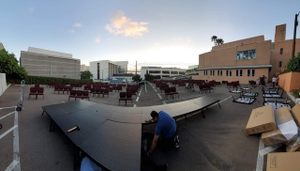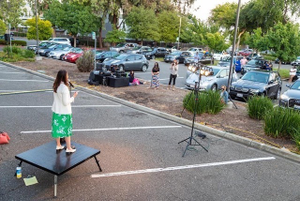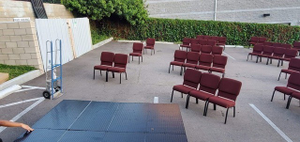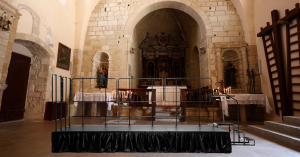
Stage skirting is a versatile tool for enhancing the visual appeal and functionality of stages. It consists of fabric or vinyl panels draped around the perimeter of a stage to conceal unsightly equipment, wiring, and structural elements. By creating a clean and polished look, stage skirting elevates the overall aesthetic of any event.
Beyond its cosmetic benefits, stage skirting also plays a crucial role in improving the acoustics of a performance space. Absorbing sound reflections helps reduce echo and enhance sound quality. Additionally, stage skirting can contribute to fire safety by acting as a barrier to prevent the spread of flames. Whether it's a corporate event, a theatrical production, or a concert, stage skirting is an essential element for creating a professional and impressive stage setup.
Guide to Setting Up Stage Skirting

Stage skirting, a seemingly simple element, can significantly elevate the visual appeal and functionality of your stage. By strategically concealing unsightly equipment, wires, and structural components, skirting creates a clean, polished, and professional look. Let's delve into a step-by-step guide to ensure a flawless installation.
Step 1: Precise Measurement and Cutting
- Accurate Measurements: The foundation of a successful installation lies in precise measurements. Use a measuring tape to determine the exact height and length of your stage.
- Tailored Cutting: Armed with accurate measurements, cut your skirting material using sharp scissors or a utility knife. Ensure straight cuts to avoid uneven edges and a messy appearance.
Step 2: Secure the Velcro
- Prep the Surface: Before attaching the Velcro, thoroughly clean the bottom edge of the stage deck to remove any dirt, debris, or residue. A clean surface ensures a strong bond.
- Strategic Placement: Apply strips of firm, industrial-grade Velcro to both the top edge of the skirting material and the bottom edge of the stage deck. Maintain even spacing between the strips for a secure and consistent fit.
Step 3: Attach the Skirting
- Aligning the Velcro: Carefully align the Velcro strips on the skirting with those on the stage deck to ensure a seamless connection.
- Firm Pressure: Press the skirting firmly onto the stage deck to create a strong bond between the Velcro strips.
- Smooth the Fabric: Smooth out any wrinkles or creases in the fabric to achieve a sleek and polished look. This attention to detail enhances the overall visual appeal of the stage.
Step 4: Secure the Skirting
- Reinforcement: For added security, especially in windy conditions or high-traffic areas, consider using additional clips, weights, or tension rods to secure the skirting to the stage.
- Weighting the Bottom: Attaching weights to the skirting's bottom hem can prevent it from flapping or lifting, ensuring a stable and professional appearance.
Tips for a Professional Finish
A few extra practical tips to elevate your stage skirting from good to great.
- Iron Out the Wrinkles: Before attaching the skirting, iron it to remove any creases or wrinkles from rough side. A smooth, wrinkle-free surface creates a polished and professional look.
- Level It Up: Use a level to ensure that your skirting hangs straight and even. A level of skirting adds to the overall aesthetic appeal of your stage.
- Color Coordination: Choose a skirting color that complements the theme and color scheme of your event. This creates a cohesive and visually pleasing stage design.
- Prioritize Safety: Ensure that your skirting material meets local fire safety regulations. Opt for flame-resistant fabrics to minimize fire hazards, especially in large-scale events. Use stage railings to avoid any tripping hazards and ensure your performers are safe.
Planning for Install Stage Skirting

Before embarking on your portable stage skirting installation, careful planning is essential to ensure a seamless and successful outcome. Consider the following factors:
Venue Assessment
- Precise Measurements: Accurately measure the height and length of your stage to determine the exact amount of skirting material required.
- Identifying Obstacles: Note any potential obstacles, such as pillars, uneven floors, or limited access points. These factors can impact your installation strategy and may require additional planning or adjustments.
- Accessibility Considerations: Ensure that there are adequate access points, like doorways, elevators, or stairwells, to transport and set up the skirting material efficiently, especially if dealing with large or heavy materials.
Aesthetics and Theme
- Color Coordination: Choose a skirting color or pattern that harmonizes with your event's overall theme and color palette. This creates a cohesive and visually appealing stage design.
- Material Selection: Select a material that matches your event's style and ambiance. For instance, a sleek, modern event might benefit from vinyl skirting, while a traditional event may call for fabric skirting.
Budget Considerations
- Material Costs: Consider the cost of purchasing the skirting material, including fabric, vinyl, or other options. Factor in any additional materials needed, such as Velcro, clips, or weights.
- Labor Costs: If you plan to hire professionals for the installation, factor labor costs into your budget. This can include charges for measuring, cutting, attaching, and securing the skirting.
- Rental Costs: If renting the skirting, determine the rental fees and any additional charges associated with delivery, setup, and teardown.
Essential Tools and Materials
To successfully install stage skirting, you'll need the following tools and materials:
- Measuring Tape: These are used for accurate measurements of the stage.
- Scissors or Utility Knife: This is used to cut the skirting material to size.
- Velcro Tape: It is used to attach the skirting to the stage.
- Weights or Clips: To secure the skirting in place, especially in windy conditions.
- Iron: To remove wrinkles from fabric skirting.
- Level: To ensure the skirting is hung straight and evenly.
Why Use Stage Skirting
Stage skirting is more than just a decorative element; it serves several crucial functions that can significantly enhance the overall production value of your event.
Aesthetics
- Clean and Professional Look: Stage skirting instantly elevates the visual appeal of your stage, creating a polished and professional look.
- Theatrical Ambiance: Skirting helps to immerse the audience in the performance by concealing the stage's underlying structure and equipment.
Functionality
- Concealing Equipment: Stage skirting effectively hides unsightly equipment, wires, and cables, ensuring a clean and clutter-free stage.
- Improving Stage Safety: By covering sharp edges and potential hazards, skirting helps to create a safer environment for performers and technicians.
Brand Promotion
- Custom Branding: Stage skirts provide an excellent opportunity to showcase your brand or event logo. Custom-printed skirting can be a powerful marketing tool.
- Themed Events: For themed events, stage skirt can be customized to match the specific theme, creating a cohesive and immersive experience.
Sound Improvement
- Acoustic Benefits: Stage skirting can help to improve the acoustics of a performance space. Absorbing sound reflections can reduce echo and enhance sound quality.
- Sound Isolation: In specific applications, stage skirts can help to isolate sound and prevent it from bleeding into adjacent areas.
Choosing the Right Stage Skirting
Selecting the right stage skirt is essential to achieve a polished and professional look for your event. Consider the following factors when making your choice:
Material Options
- Fabric:
- Lightweight and versatile, fabric skirting is ideal for your next event setup.
- It comes in a wide range of colors and textures, allowing for customization to match your event's theme.
- However, fabric can be more susceptible to wrinkles and damage from moisture.
- Vinyl:
- Durable and water-resistant, vinyl skirting is perfect for outdoor events or stage platforms exposed to the elements.
- It's easy to clean and maintain, and it's available in various colors and finishes.
- While vinyl is more durable, it may not offer the same level of elegance as fabric.
Color and Design
- Solid Colors:
- Classic and timeless, solid-color skirting provides a clean and minimalist look.
- It's a versatile option that can complement any event theme.
- Patterns and Prints:
- Add visual interest and branding to your stage with patterned or printed skirting.
- You can choose from a variety of designs, including geometric patterns, floral motifs, and custom logos.
Fire Safety Regulations
- Local Codes: Always ensure that your chosen stage skirting material complies with local fire safety regulations.
- Flame-Resistant Fabrics: Opt for flame-resistant stage skirt fabrics to minimize fire hazards, especially in large-scale events.
Conclusion
Ready to transform your stage from ordinary to extraordinary? With the proper planning, materials, and a bit of creativity, you can elevate your event to new heights. Remember, a portable stage for sale which is well-skirted not only looks professional but also enhances the overall acoustics and safety of your performance space.
So, what are you waiting for? Dive into the world of stage skirting and let your imagination run wild. Share your stage skirting creations with us on social media and inspire others!






